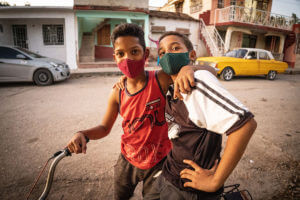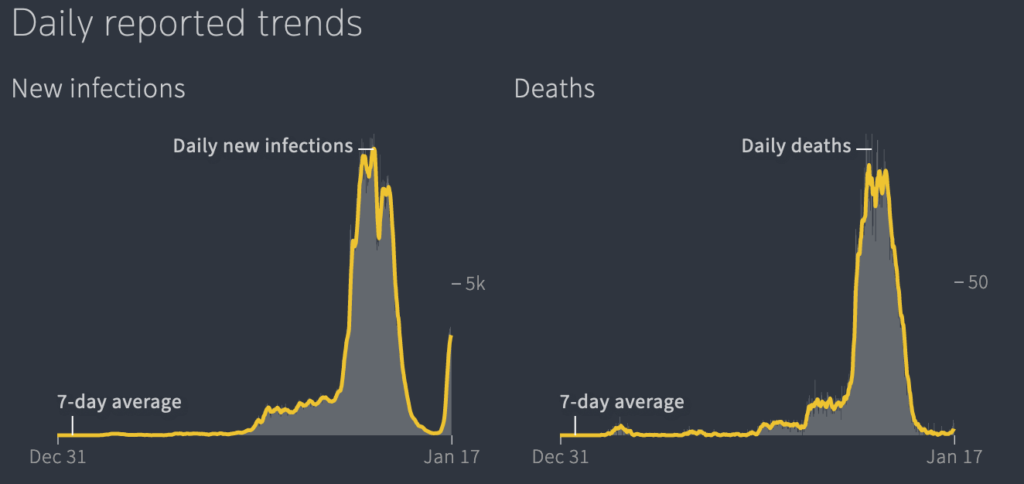The seriousness in which virtually all Cubans take COVID-19 precautions is evident in the widespread use of face masks and pride in which the citizens take in recounting their vaccination experience. One sees the carefully-covered faces of Cubans of all ages in the streets, shops, and universally in all manner of public transportation. I was surprised to see individuals with their faces covered by the “nasobuco,” as the device is called there, even when riding horses in the countryside or amongst the elderly in remote villages.
On one occasion when I absent-mindedly left my lodgings without covering and entered the streets of Sancti Spiritus, I was quickly remonstrated by a young man, who rapidly pointed to his nasobuco and motioned to me. He observed me until I had fastened my own mask and proceeded apace.
When Cuba re-opened the nation to tourism in November, it did so under the most stringent protocols of screening visitors for COVID-19. Upon my entry to José Martí airport, I had to show my COVID-19 vaccination card on three occasions. When I rented a room at the Trinidad casa particular, I had to proffer the card, and I was careful to always have it in my possession.
 When the COVID-19 pandemic began, Cuba could not wait on the rest of the world to develop vaccines. My homeland’s 60-year-old economic embargo and de facto blockade against the country, which prevents US-made products from being exported there, made it impossible for Cuba to acquire vaccines and therapies. “It was best, for protecting our population, to be independent,” said Vicente Vérez Bencomo, director-general of the Finlay Institute of Vaccines in Havana. But has Cuba beat COVID with its homegrown vaccines?
When the COVID-19 pandemic began, Cuba could not wait on the rest of the world to develop vaccines. My homeland’s 60-year-old economic embargo and de facto blockade against the country, which prevents US-made products from being exported there, made it impossible for Cuba to acquire vaccines and therapies. “It was best, for protecting our population, to be independent,” said Vicente Vérez Bencomo, director-general of the Finlay Institute of Vaccines in Havana. But has Cuba beat COVID with its homegrown vaccines?
The Finlay Institute and Cuba’s other state-run biotechnology centres started developing their own COVID-19 vaccines in the hope that at least one of them would be effective. As of November, 2021, their bet seemed to be paying off: in a November 2021 document published on medRxiv, Vérez Bencomo and his colleagues reported that one of the institute’s vaccines, Soberana-2, was more than 90% effective in protecting against symptomatic COVID-19 infection when used in combination with a related vaccine.
The combination seemed to be effective to mitigate the highly transmissible Delta variant of the coronavirus SARS-CoV-2, which caused surges in hospitalizations and death across the world. But Delta greatly increased COVID-19 cases in Cuba.
 As of the end of 2021, 89% of Cuba’s population — including children as young as 2 — has received at least one dose of Soberana 02 or another Cuban vaccine called Abdala, which is produced at the Center for Genetic Engineering and Biotechnology (CIGB) in Havana. The center reported in July, 2021 that Abdala, a three-dose vaccine, was more than 92% effective in phase III trials that included more than 48,000 participants.
As of the end of 2021, 89% of Cuba’s population — including children as young as 2 — has received at least one dose of Soberana 02 or another Cuban vaccine called Abdala, which is produced at the Center for Genetic Engineering and Biotechnology (CIGB) in Havana. The center reported in July, 2021 that Abdala, a three-dose vaccine, was more than 92% effective in phase III trials that included more than 48,000 participants.
Cuba’s regulatory agency authorized Abdala and Soberana 02 shots for use in adults in July and August respectively, and health-care workers began immunizing children with both vaccines a few months later. As many Cubans recount with evident pride, the country then began exporting the  two home-grown vaccines to Venezuela, Vietnam, Iran and Nicaragua. And the government then asked the World Health Organization to approve its vaccines — an important step toward making them available throughout the developing world.
two home-grown vaccines to Venezuela, Vietnam, Iran and Nicaragua. And the government then asked the World Health Organization to approve its vaccines — an important step toward making them available throughout the developing world.
In September, as the Delta variant surged, a new list of fines for COVID-related infractions was promulgated by the Cuban Ministry of Justice, and this may be one more reason for the seriousness in which Cubans take their public health precautions. The fines ranged from 2,000 to 3,000 Cuban pesos (from U.S. $80 to $120 at the official exchange rate) for flouting restrictions including improper use of the nasobuco or for hotels not adhering to the regulations.
In spite of all this effort, as of the end of the year, there were more than one million infections and 8,345 coronavirus-related deaths reported on the island since the pandemic began.
 UPDATE: How has Cuba fared with the more contagious Omicron variant? COVID-19 infections are increasing in Cuba, with 3,290 new infections reported on average each day. That’s 35% of the peak — the highest daily average reported on August 22, 2021. As of January 20, 2022, the average number of new infections reported each day in Cuba increased by more than 3,100 over the prior three weeks. This represents an increase of 33% of its previous peak.
UPDATE: How has Cuba fared with the more contagious Omicron variant? COVID-19 infections are increasing in Cuba, with 3,290 new infections reported on average each day. That’s 35% of the peak — the highest daily average reported on August 22, 2021. As of January 20, 2022, the average number of new infections reported each day in Cuba increased by more than 3,100 over the prior three weeks. This represents an increase of 33% of its previous peak.
The Cuban Ministry of Health reports that, by mid-January, more than 33 million doses of the Soberana-2, Soberana+, and Abdala vaccines had been administered. It also stated that more than 10.5 million persons had received these vaccines and of these 9.3 million the second and nearly 9 million the third dose. These and other factors highlight the success of the Cuban’s fight against the pandemic of our time.

0 Comments